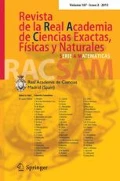Abstract
The connection between probability and g-integral is investigated. The purposes of this paper are mainly to introduce the concept g-expectation with general kernels on a g-semiring, and then extend the Jensen type inequality in general form, thus refining the previous results in probability and measure theory.
Similar content being viewed by others
References
Agahi, H., Babakhani, A., Mesiar, R.: Pseudo-fractional integral inequality of Chebyshev type. Inf. Sci. 301, 161–168 (2015)
Agahi, H., Mesiar, R., Ouyang, Y.: Chebyshev type inequalities for pseudo-integrals. Nonlinear Anal. 72, 2737–2743 (2010)
Bede, B., Regan, D.O’.: The theory of pseudo-linear operators. Knowl. Based Syst. 38, 19–26 (2013)
Breckner, W.W.: Stetigkeitsaussagen fiir eine Klasse verallgemeinerter convexer funktionen in topologischen linearen Raumen. Pupl. Inst. Math. 23, 13–20 (1978)
Dragomir, S.S.: A new refinement of Jensen’s inequality in linear spaces with applications. Math. Comput. Model. 52, 1497–1505 (2010)
Farenick, D.R., Zhou, F.: Jensen’s inequality relative to matrix-valued measures. J. Math. Anal. Appl. 327, 919–929 (2007)
Grobler, J.: Jensen’s and martingale inequalities in Riesz spaces. Indag. Math. 25, 275–295 (2014)
Hamm, A.: Uncertain dynamical systems defined by pseudomeasures. J. Math. Phys. 38(6), 3081–3109 (1997)
Kolokoltsov, V.N., Maslov, V.P.: Idempotent analysis and its applications. Kluwer Academic Publishers, Dordrecht, Boston, London (1997)
Kaluszka, M., Okolewski, A., Boczek, M.: On the Jensen type inequality for generalized Sugeno integral. Inf. Sci. 266, 140–147 (2014)
Khan, M.A., Khan, G.A., Ali, T., Kilicman, A.: On the refinement of Jensen’s inequality. Appl. Math. Comput. 262, 128–135 (2015)
Kilbas, A.A., Srivastava, H.M., Trujillo, J.J.: Theory and applications of fractional differential equations. North-Holland Mathematics Studies, vol. 204. Elsevier, Amsterdam (2006)
Kuich, W.: Semirings languages automata. Springer-Verlag, Berlin (1986)
Leorato, S.: A refined Jensen’s inequality in Hilbert spaces and empirical approximations. J. Multivar. Anal. 100, 1044–1060 (2009)
Lerner, V.S.: The boundary value problem and the Jensen inequality for an entropy functional of a Markov diffusion process. J. Math. Anal. Appl. 353, 154–160 (2009)
Niculescu, C.P., Persson, L.-E.: Convex functions and their applications. A Contemporary Approach, Springer, Berlin (2006)
Maslov, L.E., Samborskij, L.E. (eds.): Idempotent analysis. Advances in Soviet Mathematics, vol. 13. Amer. Math. Soc., Providence (1992)
Merkle, M.: Jensen’s inequality for medians. Stat. Probab. Lett. 71, 277–281 (2005)
Merkle, M.: Jensen’s inequality for multivariate medians. J. Math. Anal. Appl. 370, 258–269 (2010)
Mesiar, R., Pap, E.: Idempotent integral as limit of \(g\)-integrals. Fuzzy Sets Syst. 102, 385–392 (1999)
Pap, E.: An integral generated by decomposable measure. Univ. Novom Sadu Zb. Rad. Prirod. Mat. Fak. Ser. Mat. 20(1), 135–144 (1990)
Pap, E.: Applications of the generated pseudo-analysis on nonlinear partial differential equations. In: Litvinov, G.L., Maslov, V.P. (eds.) Contemporary Mathematics, vol. 377, American Mathematical Society, Providence, Rhode, Island (2005)
Pap, E.: \(g\)-Calculus. Univ. u Novom Sadu Zb. Rad. Prirod. Mat. Fak. Ser. Mat. 23(1), 145–156 (1993)
Pap, E.: Pseudo-analysis as a mathematical base for soft computing. Soft Comput. 1, 61–68 (1997)
Pap, E.: Pseudo-additive measures and their applications. In: Pap, E. (ed.) Handbook of measure theory, pp. 1403–1468. North-Holland, Elsevier, Amsterdam (2002)
Pap, E., Ralević, N.: Pseudo-Laplace transform. Nonlinear Anal. 33, 553–560 (1998)
Pap, E., Štajner, I.: Generalized pseudo-convolution in the theory of probabilistic metric spaces, information, fuzzy numbers, optimization, system theory. Fuzzy Sets Syst. 102, 393–415 (1999)
Pap, E., Štajner, I.: Pseudo-\(L^{p}\) space and convergence. Fuzzy Sets Syst. 238, 113–128 (2014)
Pap, E., Štrboja, M.: Generalization of the Jensen inequality for pseudo-integral. Inf. Sci. 180, 543–548 (2010)
Román-Flores, H., Flores-Franulič, A., Chalco-Cano, Y.: A Jensen type inequality for fuzzy integrals. Inf. Sci. 177(15), 3192–3201 (2007)
Štrboja, M., Grbić, T., Štajner-Papuga, I., Gruji ć, G., Medić, S.: Jensen and Chebyshev inequalities for pseudo-integrals of set-valued functions. Fuzzy Sets Syst. 222, 18–32 (2013)
Sugeno, M.: Theory of fuzzy integrals and its applications. Ph.D. Thesis, Tokyo Institute of Technology (1974)
Terán, P.: Jensen’s inequality for random elements in metric spaces and some applications. J. Math. Anal. Appl. 414, 756–766 (2014)
Sugeno, M., Murofushi, T.: Pseudo-additive measures and integrals. J. Math. Anal. Appl. 122, 197–222 (1987)
Wang, Z., Klir, G.J.: Generalized measure theory. Springer, Boston (2009)
Acknowledgments
The authors are very grateful to Editor and to the anonymous reviewers for many helpful suggestions and discussions of the manuscript. The second author acknowledges the support of grant APVV-14-0013.
Author information
Authors and Affiliations
Corresponding author
Appendix
Appendix
Proof of Theorem 1.2
We use the inequality
for any \(x,\rho \in I\) which follows from convexity of \(\Psi \). Multiplying both sides of (5.1) by \(k\left( \omega _{1},\omega _{2}\right) \), we have
We set \(x=X\left( \omega _{2}\right) \) and \(A_{\mathbf {id}}^{k,\Omega _{2}} \left[ X\right] (\omega _{1})=\frac{1}{K_{\mathbf {id}}^{\Omega _{2}}(\omega _{1})}\int \nolimits _{\Omega _{2}}\left( k\left( \omega _{1},\omega _{2}\right) X\left( \omega _{2}\right) \right) d\mu _{2}\left( \omega _{2}\right) =\rho \) and integrate over the domain \(G=\left\{ \omega _{2}\in \Omega _{2}:X\left( \omega _{2}\right) \ne 0\right\} .\) Then
which gets the desired inequality
This completes the proof. \(\square \)
Proof of Theorem 1.4
. Using (5.2), set \( x=X\left( \omega _{2}\right) \) and
and integrate over the domain \(G=\left\{ \omega _{2}\in \Omega _{2}:X\left( \omega _{2}\right) \ne 0\right\} .\) Then
So,
This completes the proof. \(\square \)
Rights and permissions
About this article
Cite this article
Agahi, H., Mesiar, R. & Babakhani, A. Generalized expectation with general kernels on g-semirings and its applications. RACSAM 111, 863–875 (2017). https://doi.org/10.1007/s13398-016-0322-2
Received:
Accepted:
Published:
Issue Date:
DOI: https://doi.org/10.1007/s13398-016-0322-2


